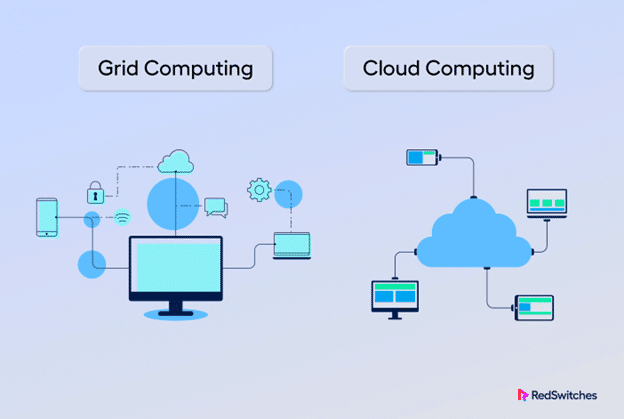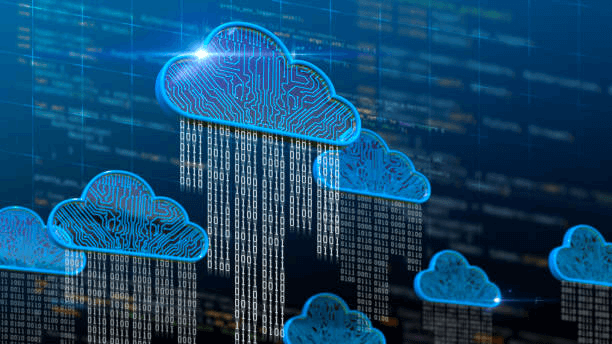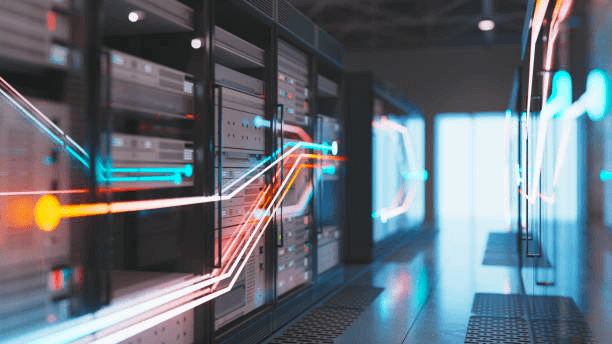As AI, Big Data, and the IoT have spread, the need for computing power has skyrocketed in recent years. It has increased interest in implementing distributed computing solutions like grid and cloud computing. However, most businesses and people need to learn the difference between grid computing vs. cloud computing.
First, grid and cloud computing are examples of distributed computing models, each with benefits and drawbacks. Grid computing relies on a computer network to share processing power, storage capacity, and other resources to perform complex tasks. Cloud computing employs a centralized architecture that allows users and businesses to access computing resources via the Internet.
This article will define what grid and cloud computing mean—examining their architecture, deployment, maintenance, cost, and security differences. We’ll also investigate their suitability for different computing needs and their impact on businesses and users. We will explore each technology and help readers determine which suits their daily business needs best.
Table of Content
- What Is Cloud Computing?
- What Is Grid Computing?
- Types of Grid Computing Systems
- Grid Computing vs. Cloud Computing: The Differences
- Picking Between Cloud Computing and Grid Computing
- Final Takeaway
- FAQs
What Is Cloud Computing?
The term “cloud computing” describes providing data storage, computational power, and software applications through the Internet on demand. Eliminating the user’s responsibility for software and hardware installation and upkeep is a significant advantage of cloud computing.
The resources are available to users on a “pay as you go” basis, so they are only required to cover the costs of what they use. It makes cloud computing an attractive choice for organizations and people seeking scalable and adaptable computing at a reasonable price.
Cloud Computing Characteristics
There are several key cloud computing characteristics, and they include:
- Resource Pooling: With the cloud, suppliers pool resources from several servers and allocate them to consumers on an as-needed basis, reducing inefficiencies and maximizing productivity.
- Rapid Elasticity: While using cloud computing, increasing or decreasing the available resources in response to fluctuating demand is simple.
- Measured Service: Cloud service providers monitor their customers’ consumption of resources and bill them accordingly.
- On-Demand Self-Service: Through “the cloud,” users can access the service provider’s computing resources on-demand without involvement from the provider’s end.
What Is Grid Computing?
It’s a type of distributed computing that pools assets from multiple computers and networks into one shared infrastructure. It facilitates the effective processing of big data sets and solving complex problems. In addition, it accomplishes that using the combined processing capacity of multiple organizational computers.
The way grid computing works is to divide tasks into smaller parts and distribute them around the grid, with each node executing a tiny amount of the overall workload. The technique can shorten the time to finish the job and improve speed and accuracy. This technique is common in engineering, science, and other disciplines that require intricate computations.
Characteristics of Grid Computing
Here are some of the critical characteristics of grid computing:
- Distributed Resources: It relies on a network of geographically dispersed computing resources connected via high-speed internet connections. These resources can be heterogeneous regarding hardware, software, and operating systems.
- Resource Sharing: It enables sharing computing resources among users and applications, regardless of physical location. It allows organizations to utilize idle resources and avoid the need for expensive hardware upgrades.
- Scalability: It’s highly scalable, allowing organizations to expand their computing resources as needed to meet the growing demands of their applications. Depending on the workload, you can add or remove resources dynamically from the grid.
- Standardization relies on protocols and interfaces to enable interoperability between resources and applications. It ensures you can access and use resources regardless of location or vendor.
In summary, grid computing offers a powerful and flexible way to solve complex computational problems by pooling geographically dispersed computing resources.
Types of Grid Computing Systems
Grid computing systems come in various types, each with features and architecture. Some of the most popular grid computing systems are:
- Computational Grids: They provide computing resources for complex computations, such as processing power and storage. These systems are standard in scientific research. Examples include the Open Science Grid and the European Grid Infrastructure.
- Data Grids: They provide large-scale data management and storage capabilities. These systems manage and analyze large datasets, such as those generated by particle accelerators or telescopes. Examples include the Large Hadron Collider Computing Grid.
- Collaborative Grids: They support collaboration and data sharing among geographically dispersed users. These systems are standard in research and education, where users must share data and work together on complex projects. Examples include the Community Earth System Model.
- Manuscript Grids: Its computing is a valuable framework for managing large volumes of image and text blocks. You can continuously accumulate blocks with this type of grid computing while previous block batches get processed and operated on in parallel. It efficiently processes vast volumes of manuscripts, texts, and images.
- Modular Grids: Its computing involves breaking down computing resources into modules that you can combine to support specific apps or services. This grid type allows IT teams to tailor server configurations to meet the requirements of particular applications.
Grid Computing vs. Cloud Computing: The Differences
Here is a comparison showing the difference between grid and cloud computing in tabular form:
| Feature | Cloud Computing | Grid Computing |
| Architecture
|
It has a centralized cloud computing architecture, which uses virtualization technology. | It has a decentralized architecture that uses distributed computing. |
| Cost
|
Cloud computing requires regular subscription payments, saving costs on the initial investment in hardware. | Grid computing involves a significant initial investment in hardware and software. |
| Deployment
|
Cloud computing deploys on the public, private, or hybrid cloud. | Grid computing deploys across multiple organizations, data centers, or networks. |
| Performance and Efficiency
|
Cloud computing has limited performance and efficiency because of the shared resources. | Grid computing provides better performance and efficiency for high-performance computing tasks. |
| Scalability
|
Through server scaling, cloud computing is easier to scale depending on demand. | Grid computing can scale in any way, depending on demand. |
| Security
|
Cloud computing has robust security measures and compliance frameworks. | Grid computing may have less security because of its decentralized nature. |
| Use case
|
Cloud computing is ideal for businesses that need fast deployment, flexibility, and scalability. | Grid computing is ideal for scientific research, data analysis, and large-scale simulations. |
Ultimately, it’s up to the business’s individual needs to choose which is more practical: grid computing vs. cloud computing. Cloud computing is more suitable for startups and smaller businesses because of its cost-effectiveness and flexibility. Grid computing is better suited for larger enterprises with high-performance computing demands.
Picking Between Cloud Computing and Grid Computing
Picking between grid vs. cloud computing can be challenging for businesses. Both technologies have unique pros and cons that you must weigh against each other to determine the best fit for a particular use case.
Cloud computing offers scalability, cost-effectiveness, and ease of use. Businesses can scale up or down their computing resources as needed, only paying for what they use. Many cloud computing providers offer pre-built services, reducing the resources required for development. It is an excellent option for startups and small businesses looking to keep costs low.
Grid computing, on the other hand, offers high performance and efficiency. By utilizing distributed computing resources, grid computing can process large amounts of data in parallel. It provides faster results than traditional computing methods. Grid computing is also highly customizable.
When choosing between grid computing vs. cloud computing, it is crucial to consider factors such as the nature of the workload, security requirements, and cost. For example, businesses with highly variable workloads may benefit more from cloud computing, while those with high-performance computing needs may prefer grid computing. Ultimately, the decision should depend on thoroughly understanding the business’s needs and goals.
Also Read: 6 Key Differences: Cloud vs On Premise Computing Revealed!
Final Takeaway
Throughout the article, we have broken down the difference between grid computing vs. cloud computing. Today, cloud computing has replaced grid computing as the go-to choice for enterprises and users needing distributed computing. The benefits of a centralized architecture that is simple to set up and scale are attractive.
As a result, businesses can better respond to customers’ ever-evolving needs. Cloud hosting services also provide dedicated resources and support. It results in improved performance and dependability over the distributed nature of grid computing.
The sophisticated security safeguards and rigorous data privacy policies cloud computing provides are among its most notable advantages. Companies can’t afford to ignore this benefit due to the growing incidence of cyber threats.
All-in-all, there’s no winner in the battle of grid vs. cloud computing. Both can be pretty valuable based on what the business is looking for. Although grid computing costs less, cloud hosting services are preferable because of their additional performance, reliability, and security benefits. When properly implemented, cloud computing can help organizations adapt to the ever-changing demands of the modern digital marketplace.
To learn more about grid computing vs. cloud computing, check our Cloud Computing Section.
FAQs
Do Both Work for Small Businesses?
Both cloud and grid computing can work for small businesses, but each option has pros and cons. Cloud computing is more practical and scalable, while grid computing may be more cost-effective for businesses with consistent workloads.
Which Is Safer: Grid Computing vs. Cloud Computing?
Cloud computing offers more advanced security features. Cloud hosting services have dedicated security teams, compliance certifications, and data encryption. On the other hand, grid computing is more challenging to secure due to its decentralized nature.




